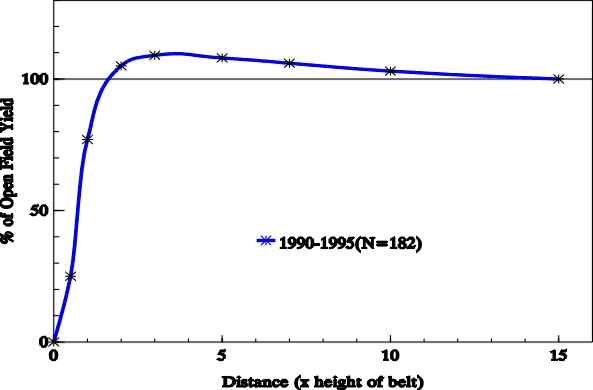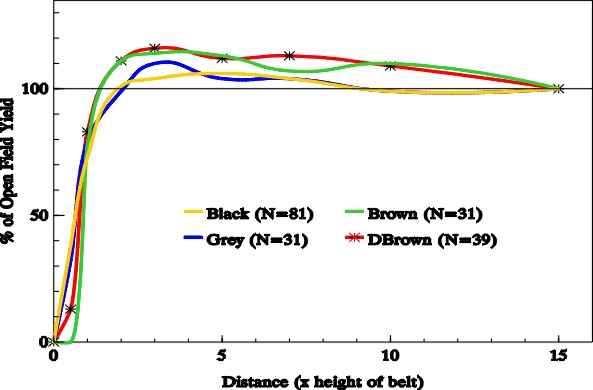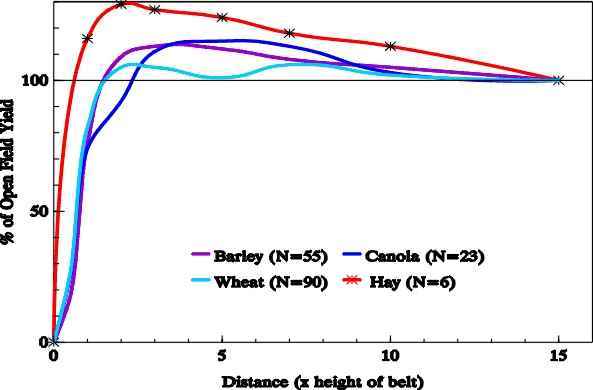| Problem
Do field shelterbelts make sense for Alberta farmers? They conserve soil and moisture, but are they economical? The objective of this study was to evaluate the effect of field shelterbelts on crop yields under local Alberta conditions.
Literature Review
Field shelterbelts provide many benefits such as trapping snow, reducing evapotranspiration, providing wildlife habitat and sequestering carbon. The most important benefit is providing protection to adjacent soil and crops from the erosive winds. In spite of these benefits, farmers are often slow to implement this conservation measure. One of their main concerns is that shelterbelts take valuable land out of production and compete with crops for moisture and nutrients. Research in other parts of Canada has shown improved yields adjacent to shelterbelts can help compensate for lost production. It was important to assess the effects on yields under Alberta conditions.
Study Description
From 1990 to 1995, 188 site years of data were collected from across Alberta. Crops included wheat, oats, barley, peas, canola and hay. The sites were located in the brown, dark brown, black and grey soil zones. Shelterbelt types included: poplar, caragana, spruce, green ash, willow, native and mixed shelterbelts.
The fields were sampled along three transects perpendicular to the shelterbelt at distances of 0.5, 1, 2, 3, 5, 7, 10, 15, 20 and 25 times the height (H) of the shelterbelt as measured from the centre of the shelterbelt (0H). The yield at each distance was calculated as a percentage of the assumed open field yield (average of 15H to 25H) to give relative yields for each distance.
Major Findings
Overall crop yield response to shelterbelts
Crop response for the combined data showed a yield reduction in the 0H to 1.5H area as compared to the open field at 15H (Figure 1). The area from 0H to 1.5H includes half the shelterbelt width and the zone where the shelterbelt competes with the crop for soil moisture and nutrients. In contrast, there was a yield increase in the 2H to 10H area with a maximum increase of 9% at 3H. In this area there is effective wind protection for the crop and the shelterbelt does not compete with the crop. The weighted average yield in the sheltered zone (0H to 15H) was 1% less than the open field yield.

Figure 1 Overall effect of field shelterbelts on annual crop yields (N is number of sites)
Most of the data were collected in the years 1993 to 1995. These years had above-average precipitation.
One cannot expect field shelterbelts to result in large increases in crop yield every year, but rather an economical response over the lifetime of the shelterbelt. Only in dry years will shelterbelts likely result in large crop yield increases.
Crop response for different soil zones
Agroclimatic or soil zones can affect the response of crops to shelterbelts. Sheltered crops in the brown and dark brown soil zones had higher relative yields over a greater relative distance than the crops grown in the black or grey soil zones (Figure 2). Crops in the brown and dark brown soil zones had a maximum yield increase of 15% at 3H and declined to open field yield at 15H. Crops in the black and grey soil zones had a maximum yield increase of about 8% at 3H to 5H and a decline to open field yield at 10H. The sheltered yield for the brown and dark brown soil zones was 2 to 3% greater than open field yield. The black and grey soil zones had a net loss of 3 to 4%. The brown and dark brown soil zones have less precipitation with more frequent dry winds than the other soil zones. Crops in these soil zones can take advantage of extra available moisture and lower evapotranspiration in the lee of the shelterbelt.

Figure 2 Effect of field shelterbelts on annual crop yields in four soil zones (N is number of sites)
Crop response for different shelterbelt types
The type of shelterbelt species and arrangement of trees in one or more rows affect wind reduction and therefore crop response. The most economical shelterbelt types were single-row, dense shelterbelts with a less invasive root systems such as spruce with an 8% increase in yield and caragana with a 1% increase in yield in the sheltered area (Table 1).
Table 1. Effect of field shelterbelt type on crop yields
| Shelterbelt type | No. of sites | Sheltered yield* |
| caragana | 89 | 101 |
| tall deciduous | 26 | 96 |
| multi-row | 33 | 96 |
| mixed | 23 | 95 |
| spruce | 7 | 108 |
| green ash | 4 | 99 |
*Sheltered yield is the weighted average yield from 0H to 15H taken as a percentage of open field yield.
Crop response for different crop types
Hay crops were by far the most responsive to field shelterbelts, with a maximum yield increase of 29% at 2H declining to open field yield at 15H (Figure 3).

Figure 3 Effect of field shelterbelts on yields of various crops (N is number of sites)
Wheat and canola had a similar response with a maximum increase in yield of 14% at 3H and declining to open field yield at 15H. Barley was much less responsive with a maximum increase in yield of 5% at 3H and declining to open field yield at 12H.
Crop response for different shelterbelt orientations
The orientation of shelterbelts is always an important consideration in shelterbelt planning. The best orientation can vary with the agroclimatic region or soil zone. For the brown soil zone, the east field had the highest crop yield response; therefore a north-south oriented shelterbelt would be most effective (Table 2). For the dark brown and black soil zone, all directions responded equally; therefore either a north-south or east-west orientation would be suitable. For the grey soil zone, an east-west shelterbelt would be best as the north and south fields had the best crop yield response.
Table 2. Effect of field shelterbelt orientation on crop yields
| Soil zone/ field direction | No. of sites | Sheltered yield* |
| brown/north | 3 | 95 |
| brown/south | 10 | 98 |
| brown/west | 8 | 97 |
| brown/east | 13 | 110 |
| dark brown/north | 9 | 102 |
| dark brown/south | 23 | 104 |
| dark brown/west | 2 | 110 |
| dark brown/east | 3 | 97 |
| black/north | 8 | 92 |
| black/south | 22 | 99 |
| black/west | 10 | 96 |
| black/east | 40 | 96 |
| grey/ north | 7 | 99 |
| grey/south | 15 | 99 |
| grey/west | 1 | 93 |
| grey/east | 8 | 92 |
* Sheltered yield is the weighted average yield from 0H to 15H taken as a percentage of open field yield.
Applied Questions
Are field shelterbelts economical?
On average in Alberta, field shelterbelts improve yields in the lee of the shelterbelt to help compensate for the loss of yield in the space occupied by the shelterbelt and in the zone where the shelterbelt competes with the crop for nutrients and moisture. In dry years, the economic advantages of shelterbelts are more pronounced.
Over the long-term, shelterbelts have a further economic benefit because they reduce the loss of soil and soil nutrients due to wind erosion. The economic benefits from reduced wind erosion were not assessed in this particular study.
Are crops more responsive to shelterbelts in certain areas of the province?
Shelterbelts reduce evapotranspiration and trap snow for improved soil moisture. The brown and dark brown soil zones have less precipitation with more frequent dry winds than the other soil zones. Therefore, crops in these soil zones have more need of the moisture conservation benefits of shelterbelts.
What types of field shelterbelts are best?
The most effective field shelterbelts are spruce and caragana because their dense branches provide good wind protection and their less invasive root systems minimize competition with the crop. However spruce is not as adaptable as caragana to the different soil and climate characteristics across the province.
Which crops respond best to field shelterbelts?
The most responsive crop is hay with a net sheltered yield increase of 12%. The extensive root system and high moisture requirements of a forage species allow it to take advantage of any extra moisture trapped by the shelterbelt.
How should shelterbelts be oriented?
For the brown soil zone, a north-south oriented shelterbelt is most effective. In the dark brown and black soil zones, either a north-south or east-west orientation is effective. In the grey soil zone an east-west oriented shelterbelt is preferred.
The Canada-Alberta Environmentally Sustainable Agriculture Agreement provided funding for this study. Staff from Alberta Agriculture, Food and Rural Development, Prairie Farm Rehabilitation Administration, and agricultural service boards provided input and assistance in conducting the study
This information is provided by Craig Sprout, the late John Timmermans, Hank VanderPluym, Conservation and Development Branch, Alberta Agriculture, Food and Rural Development. |